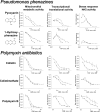Interaction of Bacterial Phenazines with Colistimethate in Bronchial Epithelial Cells
- PMID: 29784845
- PMCID: PMC6105780
- DOI: 10.1128/AAC.02349-17
Interaction of Bacterial Phenazines with Colistimethate in Bronchial Epithelial Cells
Abstract
Multidrug-resistant bacterial infections are being increasingly treated in clinics with polymyxins, a class of antibiotics associated with adverse effects on the kidney, nervous system, or airways of a significant proportion of human and animal patients. Although many of the resistant pathogens display enhanced virulence, the hazard of cytotoxic interactions between polymyxin antibiotics and bacterial virulence factors (VFs) has not been assessed, to date. We report here the testing of paired combinations of four Pseudomonas aeruginosa VF phenazine toxins, pyocyanin (PYO), 1-hydroxyphenazine (1-HP), phenazine-1-carboxylic acid (PCA), and phenazine-1-carboxamide (PCN), and two commonly prescribed polymyxin drugs, colistin-colistimethate sodium (CMS) and polymyxin B, in three human airway cell lines, BEAS-2B, HBE-1, and CFT-1. Cytotoxicities of individual antibiotics, individual toxins, and their combinations were evaluated by the simultaneous measurement of mitochondrial metabolic, total transcriptional/translational, and Nrf2 stress response regulator activities in treated cells. Two phenazines, PYO and 1-HP, were cytotoxic at clinically relevant concentrations (100 to 150 μM) and prompted a significant increase in oxidative stress-induced transcriptional activity in surviving cells. The polymyxin antibiotics arrested cell proliferation at clinically achievable (<1 mM) concentrations as well, with CMS displaying surprisingly high cytotoxicity (50% effective dose [ED50] = 180 μM) in BEAS-2B cells. The dose-response curves were probed by a median-effect analysis, which established a synergistically enhanced cytotoxicity of the PYO-CMS combination in all three airway cell lines; a particularly strong effect on BEAS-2B cells was observed, with a combination index (CI) of 0.27 at the ED50 PCA, PCN, and 1-HP potentiated CMS cytotoxicity to a smaller extent. The cytotoxicity of CMS could be reduced with 10 mM N-acetyl-cysteine. Iron chelators, while ineffective against the polymyxins, could rescue all three bronchial epithelial cell lines treated with lethal PYO or CMS-PYO doses. These findings suggest that further evaluations of CMS safety are needed, along with a search for means to moderate potentially cytotoxic interactions.
Keywords: colistimethate sodium; cytotoxicity; phenazines; polymyxins; pyocyanin; synergism.
Copyright © 2018 Mossine et al.
Figures






References
-
- Nation RL, Li J, Cars O, Couet W, Dudley MN, Kaye KS, Mouton JW, Paterson DL, Tam VH, Theuretzbacher U, Tsuji BT, Turnidge JD. 2015. Framework for optimisation of the clinical use of colistin and polymyxin B: the Prato polymyxin consensus. Lancet Infect Dis 15:225–234. doi:10.1016/S1473-3099(14)70850-3. - DOI - PubMed
Publication types
MeSH terms
Substances
LinkOut - more resources
Full Text Sources
Other Literature Sources
Medical
Research Materials
Miscellaneous

